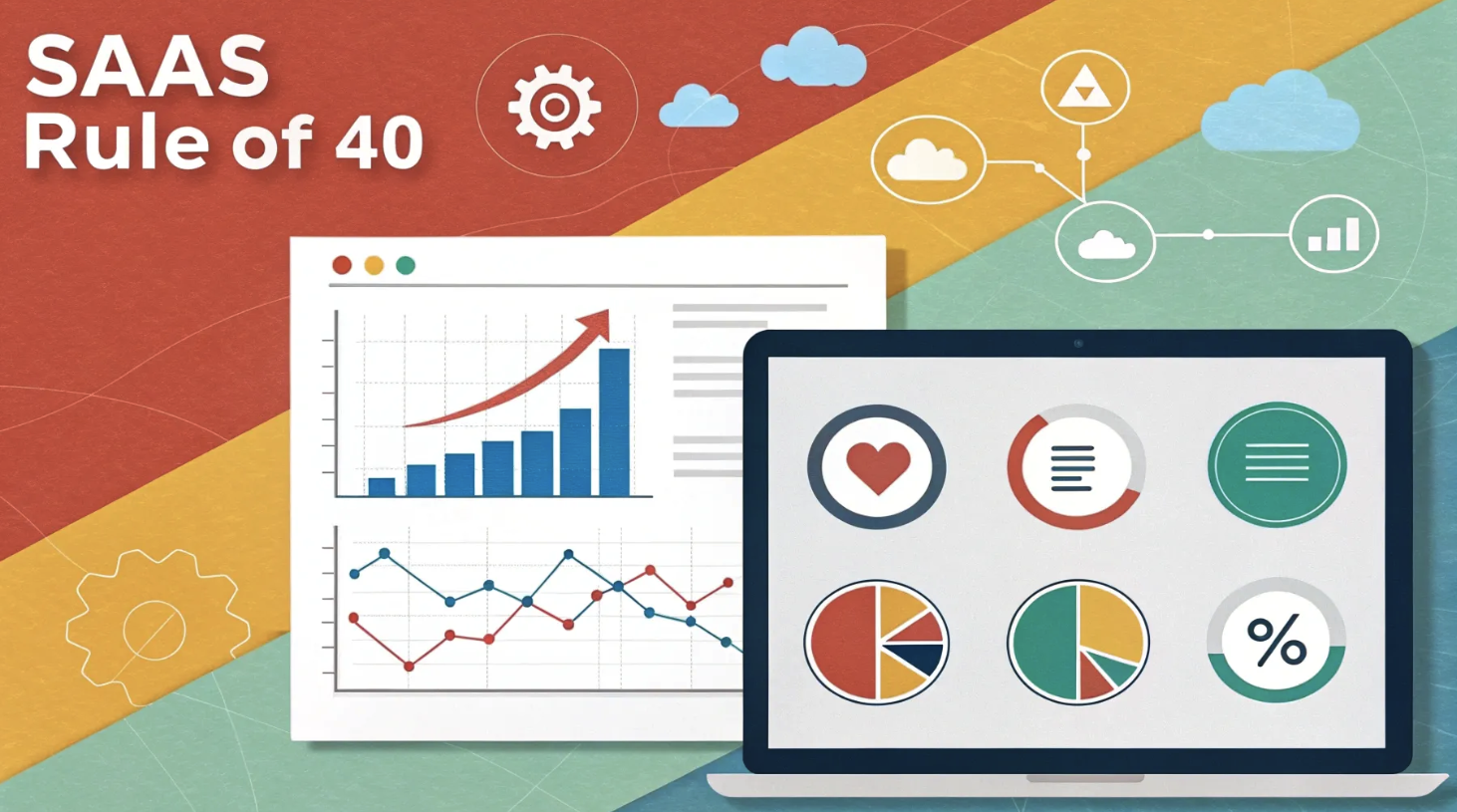
The SaaS Rule of 40 is an important financial rule to know if you are in the SaaS industry. It helps check if your business balances growth and profits well. It uses two key numbers—growth rate and profit margin—to determine your company’s financial health.
For example, a score of 40% or more means your business is doing well in both areas.
Why is this important? Companies that follow the Rule of 40 grow steadily and work better. This rule is now a trusted guide for SaaS leaders and investors. It shows how strong a business can be in the future. I shall expound more below; read on.
What Is the Rule of 40 SaaS?
Definition and purpose of the Rule of 40
The Rule of 40 is a simple way to check a SaaS company’s finances. It uses two key numbers: growth rate and profit margin. Add these numbers together, and they should be at least 40%. This shows the business is growing while staying profitable.
For example, if your company grows 25% a year and has a 15% profit margin, your score is 40%. This means your business is doing well. The Rule of 40 helps you decide whether to focus on growth or profits.
|
Aspect |
Description |
|---|---|
|
Definition |
|
|
Trade-off |
Balances growth and profitability for SaaS businesses. |
|
Benchmarking |
Helps compare forecasts but isn’t a strict rule. |
|
Valuation Impact |
Companies meeting the Rule of 40 often have higher market value. |
Why the Rule of 40 is relevant to SaaS businesses
SaaS companies grow fast but must also make money. The Rule of 40 helps them balance these goals. It’s important because SaaS businesses depend on recurring revenue, making this balance harder.
A 2021 survey showed only 29% of SaaS companies with $5 million or more in yearly revenue met the Rule of 40. This proves how tough it is to achieve. But companies that meet it often get better investor trust and higher value.
It’s a tool for smart decisions and shows stakeholders the business can last.
Origins and evolution of the metric
The Rule of 40 was introduced by Brad Feld in 2015. He learned it during a meeting about a health software company. At first, it was used for companies making over $50 million a year.
Later, it became useful for smaller companies, even those earning $1 million.
Now, the Rule of 40 is a popular guide for SaaS businesses of all sizes. It’s not a strict rule but helps companies check their finances and plan for growth and profits.
How to Calculate the Rule of 40
Key Parts: Growth rate and profit margin
You need two main numbers to figure out the Rule of 40: revenue growth rate and profit margin. These numbers show how well your SaaS business grows and makes money.
-
Revenue Growth Rate: This shows how much your company’s revenue has grown over a certain time, usually a year. It tells you how fast your business is expanding.
-
Profit Margin: This number, often found using EBITDA (Earnings Before Interest, Taxes, Depreciation, and Amortization), shows how much profit your business earns compared to its revenue.
Both numbers are important to know how healthy your business is financially. When added together, they show if your SaaS company meets the Rule of 40 standard.
Steps to calculate it
Finding the Rule of 40 is simple. Follow these steps to see if your SaaS company meets the goal:
-
Find the Revenue Growth Rate:
-
Look at your company’s past revenue numbers.
-
Use this formula:
Revenue Growth Rate = ((Current Year Revenue – Last Year Revenue) / Last Year Revenue) * 100 -
Example: If your revenue went from $10 million to $12 million, the growth rate is:
((12M - 10M) / 10M) * 100 = 20%
-
-
Find the EBITDA Margin:
-
Get your EBITDA and total revenue numbers.
-
Use this formula:
EBITDA Margin = (EBITDA / Total Revenue) * 100 -
Example: If your EBITDA is $3 million and total revenue is $12 million, the margin is:
(3M / 12M) * 100 = 25%
-
-
Add the Two Numbers:
-
Combine the revenue growth rate and EBITDA margin.
-
Example:
20% (growth rate) + 25% (EBITDA margin) = 45% -
A score over 40% means your SaaS business is doing well.
-
Rule of 40 example: Real-life calculation
Here’s an example to make it clearer. Check out this table:
|
Company |
Revenue Growth Rate |
EBITDA Margin |
Rule of 40 Score |
|---|---|---|---|
|
Company A |
30% |
20% |
50 |
|
Company B |
35% |
10% |
45 |
|
Example |
15.87% |
22.05% |
37.92% |
In this table, Company A and Company B meet the Rule of 40, showing strong performance. The example company scores below 40%, meaning it needs to improve growth or profits.
Why the Rule of 40 Matters
Balancing growth and profitability in SaaS
The Rule of 40 helps SaaS companies balance growth and profits. It combines revenue growth and profit margin into one score. This score shows how well a company is doing financially.
Prioritizing growth can result in overspending. Emphasizing profits alone can hinder business growth.
For example, SaaS Company A grew 50% but had a -5% profit margin. Their Rule of 40 score was 45%, showing strong growth despite losses. SaaS Company B grew 10% but had a 35% profit margin, also scoring 45%.
These examples show there’s no single way to succeed. The Rule of 40 helps businesses find their best balance.
|
Evidence Description |
Type of Evidence |
|---|---|
|
The Rule of 40 combines growth rate and profit margin, aiming for at least 40%. |
Financial benchmark |
|
High growth often lowers margins due to spending, while low growth needs high profits. |
Trade-off analysis |
|
Companies exceeding the Rule of 40 often have higher value. |
Valuation metric |
Role in decision-making and trade-offs
The Rule of 40 is more than a financial tool. It helps companies decide between growing fast or earning more profits. If your score is below 40%, you can choose to grow faster or improve profits.
For instance, Company A focused on growing quickly but lost money. By improving operations, they raised their Rule of 40 score. Company B was profitable but grew slowly. They invested in research to increase growth. These examples show how the Rule of 40 helps guide smart decisions.
Checking your Rule of 40 score often keeps you on track. It’s a great way to measure success and adjust plans for the future.
Importance for investors and financial evaluation
Investors like the Rule of 40 because it’s simple and useful. A score of 40% or higher shows a company balances growth and profits well. This makes the company more attractive to investors. It also shows how much recurring revenue is needed to meet goals.
Top SaaS companies with scores above 40% often have higher value. This score proves the company is strong and can succeed long-term. If you want investors, a good Rule of 40 score can make your company stand out.
|
Metric |
Explanation |
|---|---|
|
Rule of 40 |
Growth rate and profit margin should add up to 40% or more. |
|
Importance for Investors |
Companies with this score balance growth and profits, showing strength. |
|
Investment Decision Making |
Investors prefer companies with scores of 40% or higher for better returns. |
The Rule of 40 isn’t just a number. It tells the story of your company’s financial health and future. Use it to build trust with investors and guide your business to lasting success.
Using the Rule of 40 in SaaS Companies
When the Rule of 40 Works Best
The Rule of 40 is helpful when your SaaS company grows. If your business earns $1 million or more in yearly recurring revenue (ARR), this rule can check your finances and guide decisions.
However, for new SaaS companies, fast growth matters more than profits. So, the Rule of 40 may not be useful early on.
For growing SaaS companies, the Rule of 40 helps balance growth and profits. It’s especially important during funding rounds. Investors want to see stable finances and future potential. A good Rule of 40 score can help you get better deals.
|
Company Stage |
How Rule of 40 Applies |
|---|---|
|
Early-Stage Companies |
Focus is on fast growth, so the Rule of 40 isn’t as useful. |
|
Growing SaaS Companies |
Helps balance growth and profits when revenue is steady. |
|
During Funding Rounds |
Shows financial strength to investors, improving chances of getting good funding deals. |
When and How to Measure It
The best time to measure the Rule of 40 depends on your goals. For accurate results, calculate it yearly. This avoids monthly ups and downs in revenue and profits. A yearly review gives a clearer view of your company’s finances.
A 2017 study found that 40% of SaaS companies beat the Rule of 40. Out of these, 22 companies kept this up for three years or more. These companies had double the value of those below the benchmark. Their returns were also 15% higher than the S&P 500, proving the Rule of 40’s long-term benefits.
|
Year |
Companies Beating Rule of 40 |
Companies Keeping It for 3+ Years |
Value Comparison |
Return Comparison |
|---|---|---|---|---|
|
2017 |
40% |
22 out of 53 |
Twice as high |
15% higher than S&P 500 |
Ways to Improve Your Score
If your Rule of 40 score is low, you can improve it by focusing on growth, profits, or both. To grow revenue, find the right customers, lower customer acquisition costs, and keep customers longer.
Growing through existing customers also helps.
To improve profits, make operations more efficient, adjust pricing, and cut infrastructure costs. Better gross margins and using advanced tools like analytics can boost both growth and profits.
Many SaaS companies also use AI, machine learning, and new tech to stay ahead.
|
Strategy |
Focus Area |
|---|---|
|
Find the Right Customers |
Growth |
|
Lower Customer Acquisition Costs |
Growth |
|
Keep Customers Longer |
Growth |
|
Grow Through Existing Customers |
Growth |
|
Make Operations Efficient |
Profitability |
|
Adjust Pricing |
Profitability |
|
Cut Infrastructure Costs |
Profitability |
|
Use Advanced Analytics |
Growth & Profitability |
|
Invest in AI and Machine Learning |
Growth & Profitability |
By following these steps, your SaaS company can meet the Rule of 40. This ensures financial health and long-term success.
Limitations of the Rule of 40
Challenges for early-stage SaaS companies
For new SaaS companies, using the Rule of 40 can be tricky. These businesses often focus on growing fast instead of making profits. This makes it hard to balance both goals. You might spend too much on growth and ignore profits.
This can cause money problems and overspending.
Here are some common struggles for early-stage SaaS companies with the Rule of 40:
-
Focusing too much on growth or profits can hurt stability.
-
Ignoring cash flow issues, even if the Rule of 40 is met.
-
Treating the Rule of 40 as a strict goal, leading to bad choices.
If your SaaS company is just starting, don’t stress about the Rule of 40. Use it as a guide, not a rule. Build a strong business first before aiming for this benchmark.
Situations where the Rule of 40 may not apply
The Rule of 40 doesn’t work for every SaaS business. Some companies grow fast but lose money because they invest in future growth. This can still be a smart plan.
Here’s a table showing when the Rule of 40 might not fit:
|
Scenario Description |
Growth Rate |
Profitability |
What It Means |
|---|---|---|---|
|
40% Growth, 0% Profit |
40% |
0% |
Different from a company with 40% profit and no growth. |
|
200% Growth, -160% Burn |
200% |
-160% |
Shows growth is too costly to sustain. |
|
60% Profit, -20% Shrinkage |
0% |
60% |
Suggests the business is struggling. |
If your company fits one of these cases, use other ways to measure success.
Potential misinterpretations and red flags
Misunderstanding the Rule of 40 can lead to mistakes. You might think it works for every business, but it doesn’t. For example, focusing only on getting a 40% score could make you miss other important things like keeping customers or running smoothly.
Watch out for these warning signs:
-
Chasing short-term wins instead of long-term success.
-
Cutting costs too much, which lowers product quality.
-
Ignoring market changes that affect growth and profits.
To avoid these problems, use the Rule of 40 as a guide, not a strict rule. It helps you plan better but isn’t the only way to measure success.
The SaaS Rule of 40 is a helpful way to balance growth and profits. It shows how healthy your company’s finances are and helps you make better choices. But remember, it’s a guide, not a strict rule. Every SaaS business is different, so find what works best for your goals. Most SaaS companies don’t grow fast all the time. McKinsey says only a few keep growth rates over 30-40%.
CJ Gustafson explains that a steady plan can meet the Rule of 40 with 15% growth and 25% profit at scale. This means you can adjust the rule to fit your business.
|
Source |
Key Point |
|---|---|
|
McKinsey |
Few SaaS companies keep growth rates above 30-40%. |
|
CJ Gustafson |
A steady plan can meet the Rule of 40 with 15% growth and 25% profit. |
To improve your score, focus on both growth and profits. Keep customers longer, make your operations smoother, and use tools to work smarter. These steps will help your SaaS business grow strong and last a long time.


